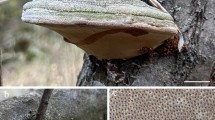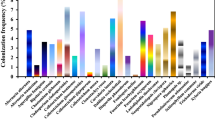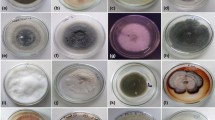Abstract
In Antarctica, fungi occupy different niches and interact with different living things; but its importance in these niches and interactions is still poorly understood. An example of an interaction reported from Antarctica involves fungi and the Antarctic mosses, in which the fungi formed rings on the carpets of mosses. However, due to the complexity of these fungi, information about these is limited, and they have not been completely characterized yet. The Antarctic region is vulnerable to climatic change, and abiotic factors can influence the growth of fungi. This may impact the pathogenic interactions between the mosses and the fungi. The aim of this study was to identify, characterize, and evaluate the pathogenic potential of a fungus isolated from moss samples Sanionia uncinata (Hedw.) Loeske. The material for this study was collected from King George Island during the Brazilian Antarctic Expedition XXXI. Through taxonomic, molecular, and phylogenetic methods, the isolate was identified as belonging to the genus Trichoderma. The isolate inhibited the growth of the moss Physcomitrium acutifolium Broth. in vitro and caused complete discolouration of its gametophytes. The physiological characterization of the isolate revealed that it was psychrotolerant with optimal growth at 20 °C, producing amylase and protease at temperatures of both 10 and 30 °C and cellulase at 10 °C only. These results suggest that an increase in temperature may enhance the occurrence of ring-forming fungi in mosses in Antarctica.





Similar content being viewed by others
References
Alexopoulous C, Mims C, Blackwell M (1996) Introductory mycology. Wiley, New York
Azmi OR, Seppelt RD (1998) The broad-scale distribution of microfungi in the Windmill Islands region, continental Antarctica. Polar Biol 19:92–100. https://doi.org/10.1007/s003000050219
Bauer A, Kirby W, Sherris JC, Turck M (1966) Antibiotic susceptibility testing by a standardized single disk method. Am J Clin Pathol 45:493
Benítez T, Rincón AM, Limón MC, Codón AC (2004) Biocontrol mechanism of Trichoderma strains. Int Microbiol 7:249–260
Bradner J, Gillings M, Nevalainen K (1999) Qualitative assessment of hydrolytic activities in Antarctic microfungi grown at different temperatures on solid media. World J Microbiol Biotechnol 15:131–132. https://doi.org/10.1023/A:1008855406319
Bridge PD, Spooner BM (2012) Non-lichenized Antarctic fungi: transient visitors or members of a cryptic ecosystem? Fungal Ecol 5:381–394. https://doi.org/10.1016/j.funeco.2012.01.007
Broady P, Given D, Greenfield L, Thompson K (1987) The biota and environment of fumaroles on Mt Melbourne, Northern Victoria Land. Polar Biol 7:97–113
Connell L, Redman R, Craig S, Rodriguez R (2006) Distribution and abundance of fungi in the soils of Taylor Valley, Antarctica. Soil Biol Biochem 38:3083–3094. https://doi.org/10.1016/j.soilbio.2006.02.016
Corte AM, Liotta M, Venturi C, Calegari L (2000) Antibacterial activity of Penicillium spp. strains isolated in extreme environments. Polar Biol 23:294–297. https://doi.org/10.1007/s003000050447
Davey ML, Tsuneda A, Currah RS (2009) Pathogenesis of bryophyte hosts by the ascomycete Atradidymella muscivora. Am J Bot 96:1274–1280. https://doi.org/10.3732/ajb.0800239
Davey ML, Currah RS (2006) Interactions between mosses (Bryophyta) and fungi. Botany 84:1509–1519. https://doi.org/10.1139/b06-120
de Albuquerque MP, Peil RMN, do Nascimento JS, (2011) Crescimento micelial de Lentinus sajor caju (Fr.) Fr. e Pleurotus spp. em diferentes resíduos agrícolas. Biosci J 28:895–902
Dix N, Webster J (1995) Fungal ecology. Chapman & Hall, London
Drummond AJ, Suchard MA, Xie D, Rambaut A (2012) Bayesian phylogenetics with BEAUti and the BEAST 1.7 Mol Biol Evol 29:1969–1973
Duong TA (1996) Infection due to Penicillium marneffei, an emerging pathogen: review of 155 reported cases. Clin Infect Dis 23:125–130. https://doi.org/10.1093/clinids/23.1.125
Esposito E, Azevedo J (2004) Fungos: uma introdução à biologia, bioquímica e biotecnologia. Educs, Caxias do Sul
Fenice M, Selbmann L, Di Giambattista R, Federici F (1998) Chitinolytic activity at low temperature of an Antarctic strain (A3) of Verticillium lecanii. Res Microbiol 149:289–300. https://doi.org/10.1016/S0923-2508(98)80304-5
Fenice M (2016) The Psychrotolerant Antarctic fungus Lecanicillium muscarium CCFEE 5003: A powerfull producer of cold-tolerant chitinolytic enzymes. Molecules 21:447. https://doi.org/10.3390/molecules21040447
Fenton JHC (1983) Concentric fungal rings in Antarctic moss communities. Trans Br Mycol Soc 80:415–420. https://doi.org/10.1016/S0007-1536(83)80038-2
Fletcher LD, Kerry EJ, Weste GM (1985) Microfungi of Mac. Robertson and Enderby Lands Antartica. Polar Biol 4:81–88. https://doi.org/10.1007/BF00442904
Gava AJ, da Silva CAB, Frias JRG (2009) Tecnologia de alimentos. NBL Editora, São Paulo
Godinho VM, Furbino LE, Santiago IF, Pellizzari FM, Yojoya NS, Pupo D, Alves TMA, Junior PAS, Romanha AJ, Zani CL, Cantrell CL, Rosa CA, Rosa LH (2013) Diversity and bioprospecting of fungal communities associated with endemic and cold-adapted macroalgae in Antarctica. ISME J 7:1434–1451. https://doi.org/10.1038/ismej.2013.77
Griffin D (1994) Fungal physiology, 2nd edn. Wiley, New York
Hawksworth D (1973) Thyronectria antarctica (Speg.) Seeler var. hyperantarctica D. Hawksw. var. nov. Br Antarct Surv Bull 32:51–53
Kern ME, Blevins KS (2003) Medical mycology-text and atlas. Premier, São Paulo
Kerry E (1990) Effects of temperature on growth rates of fungi from subantarctic Macquarie Island and Casey, Antarctica. Polar Biol 10:293–299
Khaldi N, Seifuddin FT, Turner G, Haft D, Nierman WC, Fedorova ND (2010) SMURF: genomic mapping of fungal secondary metabolite clusters. Fungal Genet Biol 47:736–741. https://doi.org/10.1016/j.fgb.2010.06.003
Leung G, Robson GD, Robinson CH (2011) Characterisation of cold-tolerant fungi from a decomposing High Arctic moss. Soil Biol Biochem 43:1975–1979. https://doi.org/10.1016/j.soilbio.2011.05.003
Longton RE (1973) The occurrence of radial infection patterns in colonies of polar bryophytes. Br Antarct Surv Bull 32:41–49
McRae CF, Seppelt R (1999) Filamentous fungi of the Windmill Islands, continental Antarctica. Effect of water content in moss turves on fungal diversity. Polar Biol 22:389–394
Mercantini R, Marsella R, Cervellati M (1989) Keratinophilic fungi isolated from Antarctic soil. Mycopathologia 106:47–52
Murashige T, Skoog F (1962) A revised medium for rapid growth and bio assays with tobacco tissue cultures. Physiol Plant 15:473–497
Pawłowska J, Istel Ł, Gorczak M, Galera H, Wrzosek M, Hawksworth DL (2017) Psychronectria hyperantarctica, gen. nov., comb. nov., epitypification and phylogenetic position of an Antarctic bryophilous ascomycete. Mycologia 109:601–607. https://doi.org/10.1080/00275514.2017.1398575
Posada D (2008) JModelTest: phylogenetic model averaging. Mol Biol Evol 25:1253–1256
Prusky D, McEvoy JL, Saftner R, Conway WS, Jones R (2004) Relationship between host acidification and virulence of Penicillium spp. on apple and citrus fruit. Phytopathology 94:44–51
Putzke J, Pereira AB (2012) Fungos muscícolas na Ilha Elefante-Antártica. Caderno de Pesquisa 24:155–164
Racovitza A (1959) Étude systematique et biologique des champignons bryophiles. Memoir Mus Natl Hist Bot 10:1–288
Raja HA, Miller AN, Pearce CJ, Oberlies NH (2017) Fungal identification using molecular tools: a primer for the natural products research community. J Nat Prod 80:756–770
Rambaut A. (2014) Figtree, a graphical viewer of phylogenetic trees. https://tree.bio.ed.ac.uk/software/figtree. Acessed 12 July 2018
Robinson CH (2001) Cold adaptation in Arctic and Antarctic fungi. New Phytol 151:341–353. https://doi.org/10.1046/j.1469-8137.2001.00177.x
Saili NS, Siddiquee S, Vui Ling CMW, González M, Vijay Kumar S (2014) Lignocellulolytic activities among Trichoderma Isolates from Lahad Datu, Sabah and Deception Island, Antarctic. J Microb Biochem Technol 6:295–302. https://doi.org/10.4172/1948-5948.1000159
Singh P, Singh SM (2012) Characterization of yeast and filamentous fungi isolated from cryoconite holes of Svalbard, Arctic. Polar Biol 35:575–583
Soares IA, Flores AC, Zanettin L, Pin HK, Mendonça MM, Barcelos RP, Trevisol LR, Carvalho RD, Schauren D, Rocha CLMS, Baroni S (2010) Identificação do potencial amilolítico de linhagens mutantes do fungo filamentoso Aspergillus nidulans. Ciência e Tecnologia de Alimentos 30:700–705. https://doi.org/10.1590/S0101-20612010000300021
Stein U, Klingauf F (1990) Insecticidal effect of plant extracts from tropical and subtropical species. J Appl Entomol 110:160–166. https://doi.org/10.1111/j.1439-0418.1990.tb00109.x
Teixeira M (1994) Obtenção de espécies de Aspergillus e Penicillium termofílicas e termotolerantes na Amazônia e caracterização de suas enzimas de interesse na indústria de alimentos. Dissertation, Instituto Nacional de Pesquisas da Amazonia
Tojo M, Van West P, Hoshino T, Kida K, Hakoda A, Kawaguchi Y, Mühlhauser HA, Van Den Berg AH, Küpper FC, Herrero ML, Klemsdal SS, Tronsmo AM, Kanda H (2012) Pythium polare, a new heterothallic oomycete causing brown discolouration of Sanionia uncinata in the Arctic and Antarctic. Fungal Biol 116:756–768. https://doi.org/10.1016/j.funbio.2012.04.005
Tosi S, Casado B, Gerdol R, Caretta G (2002) Fungi isolated from Antarctic mosses. Polar Biol 25:262–268. https://doi.org/10.1007/s00300-001-0337-8
Victoria FC, Farias DR, Bervald CMP, Da Maia LC, Sousa RO, Panaud O, de Oliveira AC (2012) Phylogenetic relationships and selective pressure on gene families related to iron homeostasis in land plants. Genome 55:883–900
Wilson JW (1951) Observations on concentric "fairy rings" in Arctic moss mat. J Ecol 39:407–416
Yamazaki Y, Tojo M, Hoshino T, Kida K, Sakamoto T, Ihara H, Yumoto I, Tronsmo AM, Kanda H (2011) Characterization of Trichoderma polysporum from Spitsnergen, Svalbard archipelago, Norway, with species density, pathogenicity to moss, and polygalacturonase activity. Fungal Ecol 4:15–21. https://doi.org/10.1016/j.funeco.2010.06.002
Zhang T, Xiang H-B, Zhang Y-Q, Liu HY, Wei YZ, Zhao LX, Yu LY (2013) Molecular analysis of fungal diversity associated with three bryophyte species in the Fildes Region, King George Island, maritime Antarctica. Extremophiles 17:757–765. https://doi.org/10.1007/s00792-013-0558-0
Zucconi L, Pagano S, Fenice M, Selbmann S, Tosi S, Onofri S (1996) Growth temperature preferences of fungal strains from Victoria Land, Antarctica. Polar Biol 16:53–61
Acknowledgements
This work integrates the National Institute of Science and Technology Antarctic Environmental Research (INCT-APA) that receives scientific and financial support from the National Council for Research and Development (CNPq process: n° 574018/2008–5), Carlos Chagas Research Support Foundation of the State of Rio de Janeiro (FAPERJ n° E-16/170.023/2008) and Foundation for Research Support of the State of Rio Grande do Sul (FAPERGS) for providing scholarship. The authors also acknowledge the support of the Brazilian Ministries of Science, Technology and Innovation (MCTI), of Environment (MMA) and Inter-Ministry Commission for Sea Resources (CIRM).
Author information
Authors and Affiliations
Corresponding author
Ethics declarations
Conflict of interest
The authors declare no conflict of interest.
Additional information
Publisher's Note
Springer Nature remains neutral with regard to jurisdictional claims in published maps and institutional affiliations.
Electronic supplementary material
Below is the link to the electronic supplementary material.
Online Resource 1: Disc diffusion method modified, after 9 days.
Online Resource 2: Average radial mycelial growth of the isolated FIMA 666-5 in different treatments. The letters represent statistical averages (p < 0.05). 1 = 1 °C; 2 = 5 °C; 3 = 10 °C; 4 = 20 °C; 5 = 30 °C; 6 = − 6 °C
Online Resource 3: Gametophytes submitted to fungal extract 50% (A); Control without addition of fungal extract (B). Both after 7 days incubation.
Online Resource 4 Confrontation test: gametophytes 10 days of incubation: (A); gametophytes with 12 days of incubation (B); gametophytes 15 days of incubation (C).
Rights and permissions
About this article
Cite this article
de Menezes, G.C.A., Alves, R.P., de Carvalho Victoria, F. et al. Study of physiological and enzymatic properties and characterization of pathogenic activity of a fungus isolated from moss Sanionia uncinata (Hedw.) Loeske in Antarctica. Polar Biol 42, 783–792 (2019). https://doi.org/10.1007/s00300-019-02473-9
Received:
Revised:
Accepted:
Published:
Issue Date:
DOI: https://doi.org/10.1007/s00300-019-02473-9




